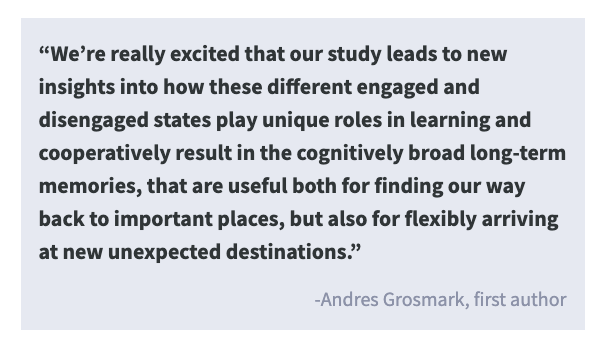Memory Reactivation Predicts the Consolidation of Long-Term Cognitive Maps
Post by Andrew Vo
The takeaway
Forming a mental map of our spatial environment involves both active (i.e., exploration) and passive (i.e., rest) processes in the brain. Reactivation of spatial memories occurs during rest and is related to how stable these memories are in the future.
What's the science?
Cognitive maps provide mental representations of our environments. They are encoded during ‘online’ exploratory periods and then consolidated through replay during ‘offline’ resting periods by place cells in the hippocampus. The neural mechanisms by which offline reactivation (i.e. reactivation of memory at rest) of spatial memories strengthen the long-term stability of such representations are still poorly understood. This week in Nature Neuroscience, Grosmark et al. track the activity of hippocampal place cells over 2 weeks to investigate the relationship between offline reactivation and the persistence of spatial memories.
How did they do it?
The authors performed calcium imaging and electrophysiological recordings to measure the activity of cells in the dorsal hippocampus of mice over 12 days. During periods of offline rest, hippocampal activity occurs in short sharp-wave/ripple (SWR) events corresponding to 125-225 Hz oscillations, and these events are thought to support offline reactivation and consolidation of memories. On each day, the mice performed three consecutive sessions, each lasting 15-20 minutes. Their heads were fixed in position to allow recording of hippocampal activity during the behavioral task. During pre- and post-run sessions, the mice would mostly rest on a cue-less treadmill belt. These two sessions were separated by a run session, during which they would run on one of two different 2-m long, cue-rich belts to obtain a spatially fixed reward.
What did they find?
During run sessions, mice spent more time near rewarded versus unrewarded locations on the belt. Recordings from hippocampal place cells revealed pronounced spatial coding and theta oscillations typically associated with online encoding. These spatial representations decayed across days, although those place cells with peak activity occurring closer to reward locations showed greater stability.
During pre- and post-run sessions, increased place cell activity and synchrony coincided with the occurrence of SWR events that are associated with offline reactivation. SWR events were more frequent and longer-lasting during post- than pre-run sessions. This increase in pre to post SWR events was greater for those place cells that coded locations farther away from reward during the run sessions, which the authors argue allows for consolidation of a more comprehensive spatial map of the underlying environment. Ensembles of place cells detected during run sessions were more strongly reactivated during post- than pre-run sessions and coincided with SWR events. Ensemble reactivation remained elevated compared to baseline for at least 24 hours following spatial exploration. Further, this cross-day ensemble reactivation was greater across pairs of days in which the animal ran on the same belt than when they ran on different belts. These findings illustrate the persistence and contextual specificity of offline reactivation across days.
Finally, the authors describe that pre to post-learning changes in SWR recruitment and memory-ensemble participation predicted place cells’ future cross-day spatial coding stability. Notably, the stability-predicting effect of SWRs was specific to the areas of the environment far from the reward. The authors suggest that this is a mechanism by which post-learning reactivation selectively stabilizes the low-salience, under-sampled areas of the cognitive map which are otherwise vulnerable to being forgotten.
What's the impact?
In summary, this study showed that hippocampal offline reactivation predicts the long-term stability of spatial representations and is most prominent for locations farthest from rewards. This process might help to stabilize representations of under-explored or less rewarding parts of the environment that are most vulnerable to memory decay, allowing for a more comprehensive cognitive map of our spatial environment. The findings here reveal a role of offline memory consolidation that is distinct from but complimentary to online learning.

